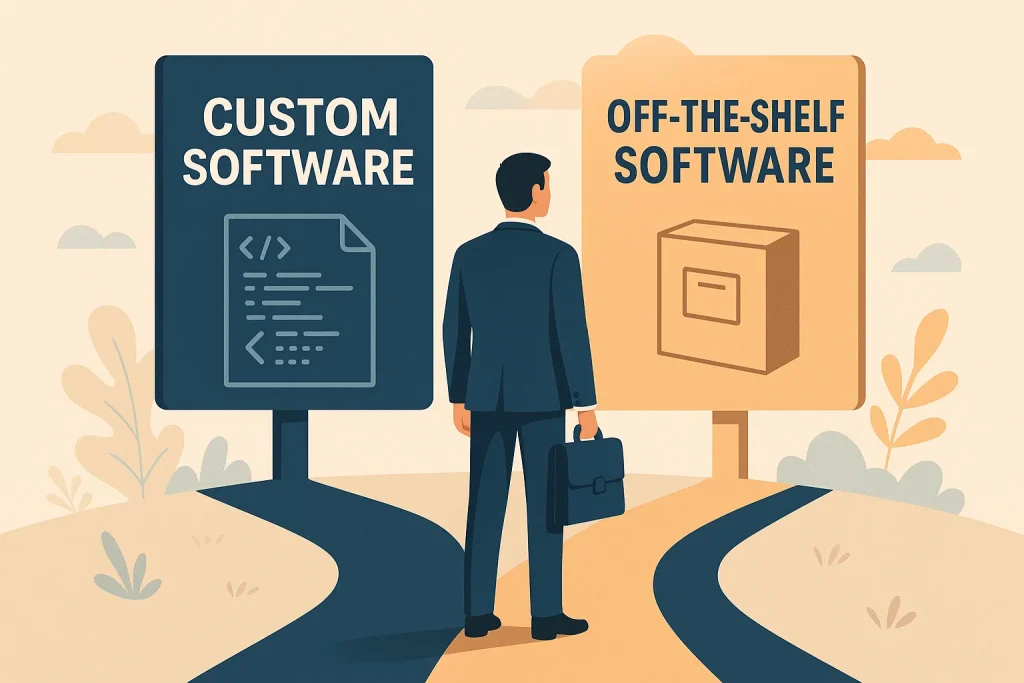In today’s economy, your personal software is fundamental. It dictates your efficiency, your growth, and your competitive edge. This reality forces every leader to a strategic crossroads: Do you buy a pre-packaged solution or build a custom application tailored to your unique operational DNA?
The “buy” option, known as commercial off-the-shelf software (COTS), is often tempting. It promises speed and a low initial price tag, but that path is frequently paved with hidden costs and frustrating limitations. The “build” option requires a significant upfront investment but offers compounding ROI, unmatched efficiency, and a powerful, proprietary business asset.
This guide moves beyond a surface-level debate. We will dissect the Total Cost of Ownership (TCO) for both options and provide a clear framework to help you make the most profitable long-term decision.
Executive Summary: Key Takeaways
- Financial Model: Off-the-shelf software has a low entry cost but a high long-term Total Cost of Ownership (TCO) due to perpetual, per-user licensing fees. Custom software requires a higher upfront investment but delivers a compounding ROI by creating a company-owned asset.
- Operational Fit: COTS forces you to adapt your unique processes to a generic tool, creating inefficiency. Custom software is built around your optimal workflow, turning your operational “secret sauce” into a competitive advantage.
- Strategic Control: With COTS, you are subject to vendor lock-in. A custom build gives you full control over your tech stack, data, and feature development, future-proofing your business
The Competitors: Off-the-Shelf vs. Custom Software
Before a meaningful comparison can be made, it’s crucial to understand precisely what each option entails.
What is Off-the-Shelf (COTS) Software?
Off-the-shelf software is designed and marketed for the mass public. Think of ubiquitous platforms like Microsoft Office 365, Salesforce, or QuickBooks. Its primary advantages are immediate availability and a seemingly low barrier to entry financially. However, by its very nature, COTS is generic and built to accommodate the most common denominator of business needs, not the specific nuances that make your company unique.
What is Custom (Bespoke) Software?
Custom software is engineered from the ground up for a single client. The process involves a deep partnership with a development team to analyze your unique workflows and build an application that addresses them directly. The goal is to create a seamless, powerful extension of your business logic, encoding your “secret sauce” into a proprietary system.
A Financial Deep Dive: The True Total Cost of Ownership (TCO)

A simple comparison of the initial price tag is profoundly misleading. A sophisticated TCO analysis reveals the real financial implications over a typical 3-to-5-year software lifecycle.
The Hidden Financial Drain of Off-the-Shelf Software
- Initial Purchase & Setup Fees: While lower than a custom build, this is rarely zero. There are often one-time setup fees, data migration charges, and mandatory onboarding packages.
- Perpetual Recurring License Costs: This is the most significant long-term drain. Most modern COTS is sold as a Software-as-a-Service (SaaS) subscription. These fees are perpetual and typically charged per user, per month.
- TCO Example: Consider a company with 75 employees using a COTS platform at $40/user/month.
- Monthly cost: 75 users * $40 = $3,000
- Annual cost: $3,000 * 12 = $36,000
- Cost over 5 years: $180,000
- This cost relentlessly scales with your headcount, penalizing you for growth.
- TCO Example: Consider a company with 75 employees using a COTS platform at $40/user/month.
- Forced Upgrades and Tier-Jumping: As your business needs evolve, you’ll inevitably require a feature that is only available in a more expensive pricing tier. You are forced to upgrade all your users, leading to a sudden and significant jump in your operational expenses.
- Integration Costs: Your business relies on a technology ecosystem, not a single tool. Getting your COTS CRM to talk to your COTS accounting software and your COTS inventory system requires expensive third-party connectors (like Zapier or Celigo at scale) or fragile custom API work, adding another layer of cost and complexity.
- The Unseen Cost of Inefficiency: This is the most underestimated financial leak. When software doesn’t match your workflow, your team is forced into time-consuming manual workarounds.
The Compounding ROI of Custom Software Investment
- The Upfront Development Cost: This is the primary hurdle. A custom software project is a significant capital investment, ranging from tens to hundreds of thousands of dollars depending on complexity. It’s crucial to view this not as an expense, but as the creation of a tangible business asset.
- Ongoing Maintenance & Hosting: Post-launch, the costs are minimal and predictable. They consist of server hosting fees and a budget for periodic maintenance and updates, which are a small fraction of the equivalent SaaS licensing costs.
- Zero Per-User Fees: This is a monumental advantage for scaling companies. Whether you have 50 users or 500 users, the cost of the software remains the same. You are no longer penalized for growing your team.
- Calculating the Positive ROI: The return on investment for custom software is multi-faceted:
- ROI from Eliminating Licenses: In our earlier example, the custom solution saves the company $180,000 in licensing fees over 5 years.
- ROI from Efficiency Gains: By automating the tasks that previously caused 10 hours of daily lost productivity, the company reclaims over $117,000 in productive work annually. Over 5 years, that’s nearly $600,000 in value.
- ROI from New Capabilities: Custom software can be designed to unlock entirely new revenue streams or service offerings that were impossible with generic tools, generating top-line growth.
Strategic & Operational Showdown: More Than Just Money

The decision impacts every facet of your operation, from day-to-day work to your long-term position in the market.
Scalability & Future-Proofing
- COTS: You scale at the mercy of your vendor. Their product roadmap, not your business strategy, dictates your future capabilities. If they decide to discontinue a feature you rely on, you have no recourse.
- Custom: The software evolves in lockstep with your business. As you expand into new markets, launch new products, or refine your processes, your software is adapted to support and accelerate that growth. You own the roadmap.
Competitive Advantage: The Unassailable Moat
- COTS: When you use the same software as your competitors, you are locked into the same “best practices” and workflows. There is no operational advantage to be gained. You are in a race to the bottom on price and service.
- Custom: A bespoke application allows you to build proprietary workflows that make your business faster, smarter, or more cost-effective than the competition. This operational excellence becomes a durable competitive advantage that cannot be easily replicated. A truly professional custom software development company doesn’t just write code; they architect a competitive weapon tailored to your business strategy.
Integration & Data Control
- COTS: Vendors often create “walled gardens,” making it difficult and expensive to get your data out or connect with other systems seamlessly.
- Custom: Custom software is built with integration in mind from day one. It is designed to be the central hub of your technology stack, communicating flawlessly with other APIs and systems, ensuring data flows freely and securely across your entire organization. You own and control 100% of your data.
Security & Compliance
- COTS: You are outsourcing a critical part of your security posture to a third party. While large vendors have robust security, a breach on their platform can expose the data of thousands of their clients, including you. Furthermore, meeting specific industry compliance standards (like HIPAA in healthcare or FINRA in finance) can be challenging with generic software.
- Custom: You control every aspect of the security architecture. The application can be built from the ground up to exceed industry-specific compliance requirements, and security protocols can be tailored to your specific risk profile, providing a much higher level of data protection and peace of mind.
For the CTO: Architectural Flexibility and Tech Stack Control
This is where the strategic argument becomes deeply technical. A custom solution removes the handcuffs of a COTS product.
- Avoiding Vendor Lock-In: You are not tied to a vendor’s technology stack, deployment environment, or feature roadmap. You have the freedom to choose the best architecture (e.g., microservices for scalability, a monolith for speed of initial development) and technologies for the job.
- API-First Design: You can build with an API-first design philosophy, ensuring your core business logic is accessible and can be seamlessly integrated with any future applications, internal or external. This turns your operations into a composable, agile ecosystem.
- True Data Sovereignty: Data sovereignty means you have absolute control over where your data is stored, how it is structured, and who can access it. With custom software, you own the database schema and can meet stringent, industry-specific compliance and security requirements (like HIPAA or GDPR) that are often difficult to guarantee with a US- or foreign-hosted COTS product.
Making the Right Choice: A Framework for Your Leadership Team

- When to Use COTS: Use off-the-shelf software for non-core, commoditized business functions where no competitive advantage is sought (e.g., standard accounting, office productivity suites).
- When to Build Custom: Prioritize a custom build when the software will support a core business process that is unique to you and a key driver of your revenue or efficiency. For businesses aiming to innovate, bespoke software development services are not a cost, but the engine of market disruption.
Conclusion: Choosing Between a Tactic and an Asset

Choosing off-the-shelf software is a short-term tactic to fill an immediate need. Choosing custom software is a long-term strategic investment in a proprietary, high-performance asset that appreciates as your business grows. It’s an investment in efficiency, scalability, and a lasting competitive advantage that cannot be replicated by your competitors.
Caroline is doing her graduation in IT from the University of South California but keens to work as a freelance blogger. She loves to write on the latest information about IoT, technology, and business. She has innovative ideas and shares her experience with her readers.







